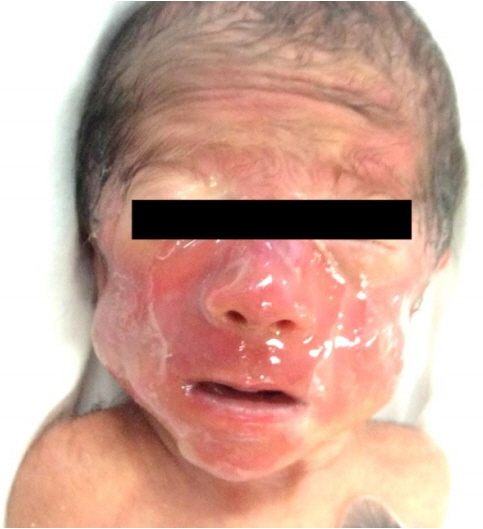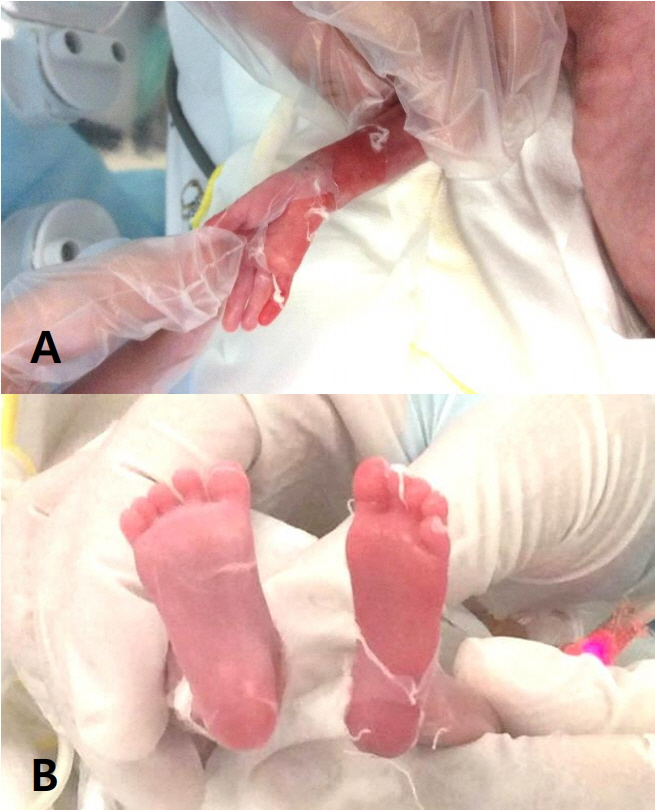Neonatal Med.
2019 Aug;26(3):174-178. 10.5385/nm.2019.26.3.174.
Sequential Cases of Staphylococcal Scalded Skin Syndrome in Very Low Birth Weight Infants
- Affiliations
-
- 1Department of Pediatrics, Jeju National University School of Medicine, Jeju, Korea. jhchoi@jejunu.ac.kr
- KMID: 2457186
- DOI: http://doi.org/10.5385/nm.2019.26.3.174
Abstract
- Staphylococcal scalded skin syndrome (4S) is an exfoliative skin disease caused by Staphylococcus aureus toxins. 4S usually has a benign course in young infants and children; however, it could be fatal in preterm infants, especially very low birth weight infants. We experienced two sequential 4S cases that occurred in the neonatal intensive care unit. One of the patients had complications such as bacteremia and acute kidney injury.
MeSH Terms
Figure
Reference
-
1. Wilson CB, Nizet V, Maldonado YA, Remington JS, Klein JO. Infectious diseases of the fetus and newborn infant. 8th ed. Philadelphia: Saunders/Elsevier;2016.2. Patel GK, Finlay AY. Staphylococcal scalded skin syndrome: diagnosis and management. Am J Clin Dermatol. 2003; 4:165–75.3. Haveman LM, Fleer A, de Vries LS, Gerards LJ. Congenital staphylococcal scalded skin syndrome in a premature infant. Acta Paediatr. 2004; 93:1661–2.4. Hoffmann R, Lohner M, Bohm N, Schaefer HE, Leititis J. Staphylococcal scalded skin syndrome (SSSS) and consecutive septicaemia in a preterm infant. Pathol Res Pract. 1994; 190:77–81.5. Amagai M, Yamaguchi T, Hanakawa Y, Nishifuji K, Sugai M, Stanley JR. Staphylococcal exfoliative toxin B specifically cleaves desmoglein 1. J Invest Dermatol. 2002; 118:845–50.6. Mockenhaupt M, Idzko M, Grosber M, Schopf E, Norgauer J. Epidemiology of staphylococcal scalded skin syndrome in Germany. J Invest Dermatol. 2005; 124:700–3.7. Davidson J, Polly S, Hayes PJ, Fisher KR, Talati AJ, Patel T. Recurrent staphylococcal scalded skin syndrome in an extremely lowbirth-weight neonate. AJP Rep. 2017; 7:e134–7.8. Johnston GA. Treatment of bullous impetigo and the staphylococcal scalded skin syndrome in infants. Expert Rev Anti Infect Ther. 2004; 2:439–46.9. Shi D, Ishii S, Sato T, Yamazaki H, Matsunaga M, Higuchi W, et al. Staphylococcal scalded skin syndrome in an extremely lowbirth-weight neonate: molecular characterization and rapid detection by multiplex and real-time PCR of methicillin-resistant Staphylococcus aureus. Pediatr Int. 2011; 53:211–7.10. Saida K, Kawasaki K, Hirabayashi K, Akazawa Y, Kubota S, Kasuga E, et al. Exfoliative toxin A staphylococcal scalded skin syndrome in preterm infants. Eur J Pediatr. 2015; 174:551–5.11. Kapoor V, Travadi J, Braye S. Staphylococcal scalded skin syndrome in an extremely premature neonate: a case report with a brief review of literature. J Paediatr Child Health. 2008; 44:374–6.12. Rieger-Fackeldey E, Plano LR, Kramer A, Schulze A. Staphylococcal scalded skin syndrome related to an exfoliative toxin Aand B-producing strain in preterm infants. Eur J Pediatr. 2002; 161:649–52.13. Coleman JC, Dobson NR. Diagnostic dilemma: extremely low birth weight baby with staphylococcal scalded-skin syndrome or toxic epidermal necrolysis. J Perinatol. 2006; 26:714–6.14. Duijsters CE, Halbertsma FJ, Kornelisse RF, Arents NL, Andriessen P. Recurring staphylococcal scalded skin syndrome in a very low birth weight infant: a case report. J Med Case Rep. 2009; 3:7313.15. El Helali N, Carbonne A, Naas T, Kerneis S, Fresco O, Giovangrandi Y, et al. Nosocomial outbreak of staphylococcal scalded skin syndrome in neonates: epidemiological investigation and control. J Hosp Infect. 2005; 61:130–8.16. Saiman L, Jakob K, Holmes KW, Whittier S, Garzon MC, Rago JV, et al. Molecular epidemiology of staphylococcal scalded skin syndrome in premature infants. Pediatr Infect Dis J. 1998; 17:329–34.17. Li MY, Hua Y, Wei GH, Qiu L. Staphylococcal scalded skin syndrome in neonates: an 8-year retrospective study in a single institution. Pediatr Dermatol. 2014; 31:43–7.18. Mishra AK, Yadav P, Mishra A. A systemic review on staphylococcal scalded skin syndrome (SSSS): a rare and critical disease of neonates. Open Microbiol J. 2016; 10:150–9.19. Jeon H, Ma SH, Jo HJ, Woo MS, An H, Park H, et al. Long-term persistence of sequence type 89 methicillin-resistant Staphylococcus aureus isolated from cases of staphylococcal scalded skin syndrome in a Korean community. J Med Microbiol. 2016; 65:1542–4.20. Lamand V, Dauwalder O, Tristan A, Casalegno JS, Meugnier H, Bes M, et al. Epidemiological data of staphylococcal scalded skin syndrome in France from 1997 to 2007 and microbiological characteristics of Staphylococcus aureus associated strains. Clin Microbiol Infect. 2012; 18:E514–21.



